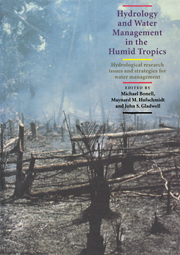 Hydrology and Water Management in the Humid Tropics
Hydrology and Water Management in the Humid Tropics Book contents
- Frontmatter
- Contents
- List of Authors
- Foreword by Federico Mayor, Director-General, UNESCO
- Preface
- Cartographic Credit
- Acknowledgements
- SECTION I INTRODUCTION
- SECTION II HUMID TROPICS SETTING
- SECTION III REGIONAL HYDROLOGY
- SECTION IV PHYSICAL PROCESSES
- SECTION V PHYSICAL PROCESSES – HUMAN USES: THE INTERFACE
- SECTION VI MANAGEMENT ISSUES
- 22 Water Resource Management
- 23 Water Management Issues: Population, Agriculture and Forests – A Focus on Watershed Management
- 24 Urban Water Resources in the Humid Tropics: An Overview of the ASEAN Region
- 25 Urban Water Problems in the Humid Tropics
- 26 Rethinking Urban Water Supply and Sanitation Strategy in Developing Countries in the Humid Tropics: Lessons from the International Water Decade
- 27 Water Resource Management Issues in the Humid Tropics
- SECTION VII APPENDICES
- Place index
25 - Urban Water Problems in the Humid Tropics
Published online by Cambridge University Press: 23 December 2009
- Frontmatter
- Contents
- List of Authors
- Foreword by Federico Mayor, Director-General, UNESCO
- Preface
- Cartographic Credit
- Acknowledgements
- SECTION I INTRODUCTION
- SECTION II HUMID TROPICS SETTING
- SECTION III REGIONAL HYDROLOGY
- SECTION IV PHYSICAL PROCESSES
- SECTION V PHYSICAL PROCESSES – HUMAN USES: THE INTERFACE
- SECTION VI MANAGEMENT ISSUES
- 22 Water Resource Management
- 23 Water Management Issues: Population, Agriculture and Forests – A Focus on Watershed Management
- 24 Urban Water Resources in the Humid Tropics: An Overview of the ASEAN Region
- 25 Urban Water Problems in the Humid Tropics
- 26 Rethinking Urban Water Supply and Sanitation Strategy in Developing Countries in the Humid Tropics: Lessons from the International Water Decade
- 27 Water Resource Management Issues in the Humid Tropics
- SECTION VII APPENDICES
- Place index
Summary
ABSTRACT
A continuous increase in urban populations and a further growth of urban agglomerations are to be expected in the world. By the year 2010, about 33 per cent of the world's population will live in urban areas. More than 50 per cent will live within the humid tropics by the year 2000. In humid tropics there are many very difficult water-related problems which urgently need solving if living conditions there are to be improved and sustainable development maintained. Most of the existing water-related problems are being intensified by the very fast development of large metropolitan areas. Problems connected to water shortages, pollution, solid waste management and the general lack of adequate data are described and exemplified with several cases. The influence of the existing social and economic structure of society on the possibilities of solving water-related problems is strongly emphasized. It is also stressed that the water sector in the urban society cannot be considered in isolation from other urban sectors, as the management of liquid and solid wastes is closely related to the management of water and other resources.
The region of the humid tropics is rather heterogeneous with regard to the various stages of development, urbanization and industrialization. The magnitude and kind of water-related problems bear some relation to the stage of development. Many problems are highly site-specific. However, several obstacles preventing reasonable water management and implementation of environmentally-sound solutions are common in many countries. These nations can be characterized as lacking sufficient economic funds, information and the data necessary to plan countermeasures. Inefficient communication between the institutions and between the users, planners and designers and a lack of adequately educated personnel also are their hallmarks.
- Type
- Chapter
- Information
- Hydrology and Water Management in the Humid TropicsHydrological Research Issues and Strategies for Water Management, pp. 535 - 546Publisher: Cambridge University PressPrint publication year: 1993


